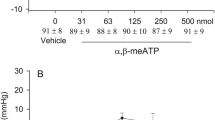Abstract
Use of selective delta opioid antagonists provide evidence that the delta receptor within the brain seems an integrated part in the mediation of respiratory depression induced by a potent analgesic like fentanyl. Low doses of the delta antagonists RX-8008M (3–6 µg/kg) as well as ICI 174,864 (3–6 µg/kg) reversed fentanyl-related respiratory depression (arterial blood gases) in the unanesthetized canine. Opioid-induced blockade of afferent sensory nerve volleys (amplitude height of the somatosensory-evoked potential) could be reversed only by a high dose (9 µg/kg) of RX-8008M. Depression of amplitude height of the SEP could not be reversed by ICI 174,864 over the whole dose range (3–6–9 µg/kg). In comparison, naloxone (1–5–10 µg/kg) not only reversed depression of P aO2, it also reversed the blockade of afferent sensory nerve impulses in the low (5-µg/kg)-dose range. A highly selective delta antagonist may have a therapeutic value in reversing opioid-related respiratory depression, resulting in little or no attenuation of analgesia.
Similar content being viewed by others
REFERENCES
W. R. Martin, E. A. Eades, J. A. Thompson, R. E. Huppler, and P. E. Gilbert. The effects of morphine and nalorphine-like drugs in the non-dependant and morphine-dependant chronic spinal dog. J. Pharmacol. Exp. Ther. 197:517–532 (1976).
W. R. Martin. Mini-Symposium II. Multiple opioid receptors. Life Sci. 28:1547–1554 (1981).
D. H. Thorpe. Opiate structure and activity—a guide to understanding the receptor. Anesth. Analg. 63:143–151 (1984).
J. E. Leysen, W. Gommeren, and C. J. E. Niemegeers. 3H-sufentanil, a superior ligand for the mu-opiate receptor: Binding properties and regional distribution in rat brain and spinal cord. Eur. J. Pharmacol. 87:209–225 (1983).
W. D. Bowen, S. Gentleman, M. Herkenhan, and C. Pert. Interconversion of opiate receptors in rat striatal patches. Proc. Natl. Acad. Sci. 78:4818–4827 (1981).
R. J. D'Amato and J. W. Holaday. Multiple opiate receptors in endotoxic shock: Evidence for delta involvement and mu-delta interactions in vivo. Proc. Natl. Acad. Sci. USA 81:2898–2901 (1984).
R. B. Rothman and T. C. Westfall. Allosteric modulation by leucine-enkephalin of (3H) naloxone binding in rat brain. Eur. J. Pharmacol. 72:365–368 (1981).
J. L. Vaught, R. B. Rothman, and T. C. Westfall. Mu and delta receptors: Their role in analgesia and in the differential effects of opioid peptides on analgesia. Life Sci. 30:1443–1455 (1982).
C. F. C. Smith. A potent opioid antagonist with some delta selectivity. Life Sci. 40:267–274 (1987).
B. S. Cotton, M. G. Miles, L. Miller, J. S. Shaw, and D. Timms. ICI 174,864: A highly selective antagonist for the opioid delta-receptor. Eur. J. Pharmacol. 97:331–332 (1984).
C. R. Chapmann, A. C. N. Chen, and S. W. Harkins. Brain evoked potentials as correlates of laboratory pain: A review and perspective. In J. J. Bonica, J. C. Liebeskind, and D. G. Albe-Fessard (eds.), Advances in Pain Research and Therapy, Raven Press, New York, 1979, Vol. 3, pp. 791–803.
E. Freye, R. Buhl, and F. Ciaramelli. Somatosensory-evoked potentials as predictors of the analgesic efficacy of nalbuphine, a mixed narcotic analgesic. Pain Clin. 1:225–231 (1987).
B. Bromm and E. Scharein. Cerebral responses in man evoked by electrical and mechanical stimuli. Neurosci. Lett. Suppl. 3:257 (1979).
P. Rohdewald, H. Derendorf, G. Drehsen, C. E. Elger, and O. Knoll. Changes in cortical evoked potentials as correlates of the efficacy of weak analgesics. Pain 12:329–341 (1982).
A. Wauquier. Neurophysiologische Untersuchungen mit dem kurzwirksamen, intravenösen Analgetikum Alfentanil. In A. Doenicke (eds.), Alfentanil, Springer, Berlin, Heidelberg, New York, Tokyo, 1982, pp. 78–89.
St. Kubicki, R. Stölzel, and R. Haas. DeAuslöschung des Fentanyl-Effektes durch Pentazocine im EEG und somato-sensorisch evoziertem Potential. In W. F. Henschel (eds.), Postoperative Schmerzbekdmpfung, Schattauer, Stuttgart, New York, 1972, pp. 103–110.
J. S. Mc Kenzie and N. R. Beechy. The effects of morphine and pethidine on somatic evoked responses in the midbrain of the cat, and their relevance to analgesia. Electroenceph. Clin. Neurophysiol. 14:501–519 (1962).
P. L. Gildenberg, K. S. Murthy, M. W. Adler, and E. A. Frost. The effect of morphine on evoked potentials in naive, tolerant and withdrawn rats. In H. W. Kosterlitz (eds.), Opiates and Endogenous Opioid Peptides, Elsevier/North-Holland, Amsterdam, 1976, pp. 247–256.
G. W. Pasternak, S. R. Childers, and S. H. Snyder. Naloxazone, a long acting opiate antagonist. Effects on analgesia in intact animals and on opiate receptor binding in vivo. J. Pharmacol. Exp. Ther. 214:455–516 (1980).
M. Wüster, M. Rubini, and R. Schulz. The preference of putative proenkephalins for different types of opiate receptors. Life Sci. 29: 1219–1227 (1981).
G. W. Pasternak and P. J. Wood. Minireview: Multiple mu opiate receptors. Life Sci. 38:1889–1898 (1986).
A. Pazos and J. Florez. Interaction of naloxone with mu-and delta-opioid agonists on respiration of rats. Eur.J. Pharmacol. 87:1309–1314 (1983).
J. S. Rosenbaum, N. H. G. Holford, and W. Sadee. In vivo receptor binding of opioid drugs at the mu site. J. Pharmacol. Exp. Ther. 233:735–740 (1985).
H. Stowell. Cerebral slow waves related to the perception of pain. Brain Res. Bull. 2:23–30 (1977).
J. A. Fleetham et al. Endogenous opiates and chemical control of breathing in humans. Am. Rev. Resp. Dis. 121: 585–590 (1980).
G. S. F. Ling, K. Spiegel, S. H. Lockhart, and G. W. Pasternak. Separation of opioid analgesia from respiratory depression: Evidence of different receptor mechanism. J. Pharmacol. Exp. Ther. 232:149–155 (1985).
A. Dray, L. Nunan, and W. Wire. Meptazinol: Unusual opioid receptor activity at supraspinal and spinal sites. Neuropharmacology 25:343–349 (1986).
G. W. Pasternak, A. Zhang, and L. Tecott. Developmental differences between high and low affinity opiate binding sites: Their relationship to analgesia and respiratory depression. Life Sci. 27:1185–1190 (1980).
S. Ward and A. E. Takemori. Determination of the relative involvement of μ-opioid receptors in opioid-induced depression of respiratory rate by use of β-funaltrexamine. Eur. J. Pharmacol. 87:1–6 (1983).
Author information
Authors and Affiliations
Rights and permissions
About this article
Cite this article
Freye, E., Schnitzler, M. & Schenk, G. Opioid-Induced Respiratory Depression and Analgesia May Be Mediated by Different Subreceptors. Pharm Res 8, 196–199 (1991). https://doi.org/10.1023/A:1015887919560
Issue Date:
DOI: https://doi.org/10.1023/A:1015887919560



